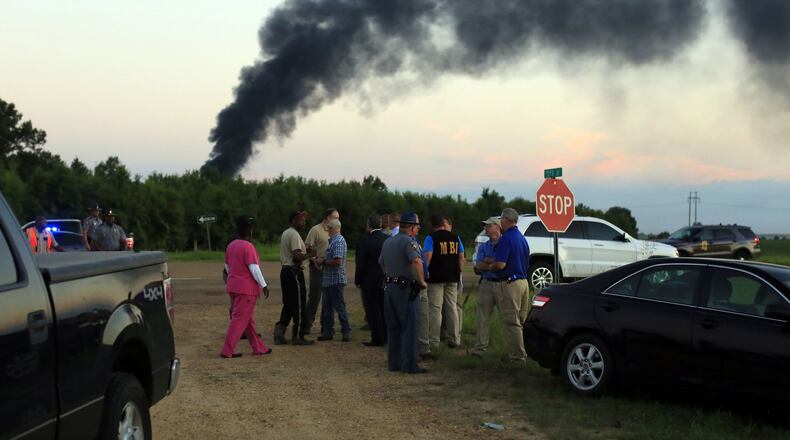Fifteen Marines and a Navy corpsman were on board the KC-130 tanker when it corkscrewed into the ground Monday afternoon about 85 miles north of Jackson, the state capital, military officials said. A witness said some bodies were found more than a mile away.
It was the deadliest Marine crash — in the U.S. or abroad — since 2005.
The Marines gave no immediate details on the cause of the crash. The FBI joined the investigation, but Marine Maj. Andrew Aranda told reporters no foul play was suspected.
The KC-130 is used to refuel aircraft in flight and transport cargo and troops.
Loren B. Thompson, a defense industry consultant with the Arlington, Va.-based Lexington Institute, said the crash of the KC-130 was “an unusual development” because its been “very reliable” for decades.
MORE: 5 things to know about the deadly military plane crash
“The C-130 aircraft is the most widely used military aircraft in the world,” he said. “It is flown by dozens of countries and it has been applied to a wide range of missions including things like fighting forest fires, collecting hurricane information and in the case of the Marine Corps aerial refueling.”
Thousands of C-130s have been built since the 1950s.
“The reliability of the aircraft is considered its biggest selling point, so this is an unusual development and we’ll have to see what the cause is in order to see what steps are necessary,” he said.
RELATED: Thunderbirds plane crashes at Dayton Air Show
The Air Force has flown C-130s since the mid 1950s in a wide range of roles, from cargo hauling to troop and medical transport.
In a statement sent to this news outlet Tuesday, the Air Force said the service branch and the Army and Navy (which includes the Marine Corps), routinely share safety program and mishap investigation information on similar aircraft.
“Naturally, the Air Force has a safety concern and interest in the Marine KC-130 safety investigation, and will act expeditiously to mitigate the risk of any hazards that are identified,” spokeswoman Laura M. McAndrews said in an email.
In Ohio, the 179th Airlift Wing at Mansfield Lahm Air National Guard Base and the 910th Airlift Wing at Youngstown Air Reserve Base both fly eight C-130H Hercules troop transport and cargo aircraft.
With the investigation under way, unit spokesmen said the wings did not plan to temporarily ground the planes, which are a different variant than the Marines fly.
“It’s been around for a long time so it’s got an incredible safety record,” said Col. David B. Johnson, a C-130 pilot and commander of the 179th Airlift Wing’s operations group “It’s the workhorse of the tactical air community.”
Eric M. White, a 910th Airlift Wing spokesman, said the Youngstown C-130 unit hasn’t had a major aircraft incident in more than three decades.
“We’ve got a pretty good record here of flying our aircraft,” he said.
Both units also expressed condolences about the Marines’ tragic aircraft crash.
“They’re going through a tough time right now,” Johnson said.
The Air Force has 145 C-130 planes in its active duty fleet; 181 in the Air National Guard; and 102 in the Air Force Reserve. The Youngstown Air Force Reserve unit is the only one in the U.S. military that flies spraying missions using pesticides and herbicides over land and oil dispersants over water, White said.
RELATED: Thunderbirds pilot recovering at home
Capt. Danielle K. Phillips, a Marine spokeswoman at the Pentagon, said Tuesday there was no indication the KC-130 fleet would be grounded.
The service branch has launched an investigation and was notifying next of kin, she said.
The air tanker assigned to a Marine reserve unit was based at Stewart Air National Guard Base in Newburgh, New York, but took off from Marine Corps Air Station Cherry Point, N.C., and was headed to Naval Air Facility El Centro, Calif., officials said.
The victims’ identities were not released pending notification of next of kin.
Andy Jones said he was working on his family’s catfish farm just before 4 p.m. when he heard a boom and looked up to see the plane spiraling downward with one engine smoking.
“You looked up and you saw the plane twirling around,” he said. “It was spinning down.”
Jones said that by the time he and others reached the crash site, fires were burning too intensely to approach the wreckage. The force of the crash nearly flattened the plane, Jones said.
“Beans are about waist-high, and there wasn’t much sticking out above the beans,” he said.
Jones said a man borrowed his cellphone to report to authorities that there were bodies across a highway, more than a mile from the crash site.
Greenwood Fire Chief Marcus Banks told the Greenwood Commonwealth that debris was scattered in a radius of about 5 miles.
Jones said firefighters tried to put out the fire but withdrew after an explosion forced them back. The fierce blaze produced black smoke visible for miles across the flat region and continued to burn after dusk, more than four hours later.
In 2005, a Marine transport helicopter crashed during a sandstorm in Iraq, killing 30 Marines and a sailor.
The Associated Press contributed to this story.
